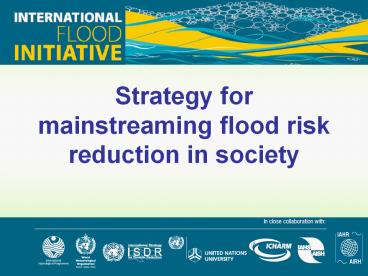Strategy for mainstreaming flood risk reduction in society - PowerPoint PPT Presentation
Title:
Strategy for mainstreaming flood risk reduction in society
Description:
Strategy for mainstreaming flood risk reduction in society * * * IFI aims to implement WSSD recommendations - taking into consideration the physical parameters of ... – PowerPoint PPT presentation
Number of Views:140
Avg rating:3.0/5.0
Title: Strategy for mainstreaming flood risk reduction in society
1
Strategy for mainstreaming flood risk reduction
in society
2
IFI aims to implement WSSD recommendations -
taking into consideration the physical parameters
of flooding, its socio-economic conditions and
the risk a society is prepared to take in order
to achieve its development objectives.IFI
promotes an integrated approach to flood
management to take advantage of the benefits of
floods and use of flood plains while minimizing
the social, environmental and economic risks.
3
IFIs overall objective is
- to build the necessary in-country capacity to
gain and advocate for a better understanding and
handling of hazards, vulnerabilities and benefits
associated with floods, by promoting all measures
through the following guiding principles - Living with floods
- Equity
- Empowered participation
- Inter-disciplinarity and trans-sectorality
- International and regional cooperation
4
Strategy for mainstreaming flood risk reduction
in society
5
Program
- Avinash Tyagi (WMO, HWR Division Director)
Main-streaming climate variability and change in
flood risk management - Yuichi Ono (ISDR ) on behalf of Sálvano Briceño
(ISDR Executive Director) Integrating flood risk
reduction in national policies for climate
adaptation and the Hyogo Framework for Action - Andreas Schumann (UNESCO) Barriers to prevent
science and technology achievements to put to
practice - Erich Plate (UNU) Examples of mainstreaming flood
preparedness in local communities - Kuniyoshi Takeuchi (ICHARM) Indicators and
standards to monitor and promote the flood
preparedness of society
6
Proposal of establishing Flood Disaster
Preparedness ISOsubmitted to the 2nd IFI
Management/Advisory Committee, Toronto, 5 May 2008
4th International Symposium on Flood Defence,
Toronto, 6-8 May 2008
- Kuniyoshi Takeuchi
- International Center for Water Hazard and Risk
Management (ICHARM) under the auspices of UNESCO,
PWRI, Tsukuba, Japan
7
Disaster reduction goal in MDGs
- Why not now?
- No reliable damage data no clear road map to
reach the goal. - An alternative goal
- The number of communities/municipalities which
satisfy a certain standard on disaster
preparedness.
8
The Hyogo Framework for Action Priorities for
Action
- Ensure that disaster risk reduction is a national
and a local priority with a strong institutional
basis for implementation. - Identify, assess and monitor disaster risks and
enhance early warning. - Use knowledge, innovation and education to build
a culture of safety and resilience at all levels. - Reduce the underlying risk factors.
- Strengthen disaster preparedness for effective
response at all levels.
9
Strong institutional basis for disaster
preparedness
It is necessary to establish a common mechanism
by which a community is encouraged, directed and
learn each other to take a rational procedure to
make themselves prepared for warning, information
dissemination, evacuation, refugee sheltering,
refugee support, recovery, receiving official and
volunteer helps, etc. etc.
10
Disaster Preparedness ISO
An international standard that any community of
any scale is suggested to follow in order to make
it prepared for natural hazards to minimize their
negative impacts and lead to quick recovery when
they occur.
The standard is not a list of facilities nor
equipments to be installed, but rather a list of
institutional procedure that any community commit
to follow to assure a positive spiral be
installed into its community management system
leading to a continuous improvement in disaster
preparedness.
11
Disaster Preparedness ISO
- Ordinary ISOs operate in the market mechanism to
increase economic profit. - Disaster Preparedness ISO operates in the public
administration mechanism to get public
satisfaction and political justification in their
performance at the time of disaster.
In a sense, the ISO license acts as an excuse to
community administration when natural disasters
do occur. If community administration has been
doing proper preparedness exercise following ISO,
they certainly deserve for such excuse.
12
Design Principles of Disaster Preparedness ISO
- Such standard may be designed under the following
principles. - Designed according to the local reality and
manageable within the local context and
administrative framework - (2) Decided, implemented, checked and revised by
the community authorities regularly and have a
built-in mechanism for continuous improvement in
a positive spiral based on plan-do-check-action
cycle. - (3) Linked with and consistent with the national
and regional emergency management scheme. - (4) Supported by the best practicable disaster
forecasting system available to the
nation/region. - (5) Internally externally reviewed and checked
regularly and re-licensing procedure should be
built-in. - (6) Evolve with societal change such as land-use
change.
13
Design Steps of Local Flood Disaster Preparedness
ISO
- Such procedure may be designed including such
steps - Form a community flood defense committee.
- Identify the goal.
- Design a set of rules of procedure to reach the
goal. - Identify the annual objectives for improvement.
- Plan and materialize the administrative,
technical and financial actions to achieve the
annual objectives. - Establish a linkage with the national/provincial
level administration. - Prepare for internal and external review
processes and re-licensing of ISO.
14
Some practices and attempts of standardization of
preparedness
- There are already some, although focuses are
different - National Fire Protection Association (NFPA) NFPA
1600 Standard on Disaster/Emergency Management
and Business Continuity Programs, 2007 Edition - ISO (2006) International Workshop Agreement, Ref
number IWA 52006(E) Emergency preparedness - ISO 9001 and 9004 A framework for disaster
preparedness - Disaster Countermeasures Basic Act of 1997, Japan
15
Role of IFI for Flood Disaster Preparedness ISO
The IFI can contribute for such needs and lead
its establishment as an integral framework of
professional organizations on flood management.
16
(No Transcript)
17
Let all the communities in the world be prepared
for disasters in positive spiral!































